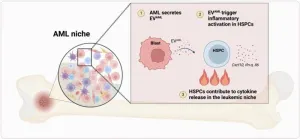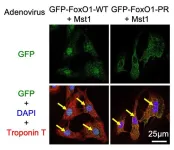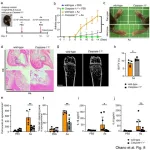(Press-News.org)
In a global first, University of Waterloo researchers have used 3D imaging technology to understand the fine details of microplastics, paving the way for more effective methods of plastic waste recycling.
Micro and nanoplastics, tiny particles of plastic that come from the breakdown of larger plastic items, have become an exponentially worsening environmental crisis. Due to their difficulties in safely decomposing, plastic pollution poses significant threats to ecosystems, wildlife and human health.
Scientists have struggled to understand the exact process of how these micro and nanoplastics degrade, particularly at the micro and nanoscale, which has hampered efforts to mitigate their environmental impact. Observing and understanding how the fine details of microplastics function and how they break down are key to eradicating them from our environment.
In collaboration with the National Research Council (NRC), researchers leveraged 3D imaging technology inaddition to traditional 2D microscopy, allowing them to observe the degradation of micro and nanoplastics with unprecedented detail.
"Most microscope images provide a two-dimensional view, similar to a medical X-ray, which gives us some information but lacks depth," said William Anderson, a professor in Waterloo’s Department of Chemical Engineering.
"However, 3D imaging is like a CT scan, offering far more detailed insights into the structure and degradation of microplastics. This level of detail has been incredibly challenging to achieve, but it's crucial for understanding what is happening at the surface of micro and nanoplastics and how degradation processes work."
The research group used a novel combination of physical and biological approaches to obtain their new visual data. They utilized a photocatalytic process, which treated micro and nanoplastics with UV light and a titanium oxide catalyst. As a result, the team could observe and analyze the degradation at a microscopic level.
"Using this methodology reveals not just that degradation is happening, but exactly how and where it's occurring on the surface of micro and nanoplastics, said chemical engineering professor Boxin Zhao, a University of Waterloo Endowed Chair in Nanotechnology. “This knowledge is crucial for developing more effective methods of breaking down plastics on the micro and nanoscales.”
Anderson and Zhao, in collaboration with researchers from the Department of Chemical Engineering and the Department of Biology at Waterloo, are developing biocycling methods where microplastics could be used as a carbon source for bacteria. These bacteria would ingest microplastics and then excrete an environmentally friendly biopolymer that could be used to create new materials like plastic bags or packaging films.
This study has broader implications for Waterloo’s research team, which is now forming a multidisciplinary plastics biocycling research initiative.
The collaboration underscores the importance of bringing together different fields of expertise to tackle complex environmental challenges. This research offers valuable insights that could pave the way for more effective methods of plastic waste recycling and contribute to a circular economy.
The study, “3D imaging photocatalytically degraded micro-and nanoplastics”, was recently published in IOPSCIENCE.
END
“In this research perspective, we discuss recent work from our lab describing an active role of HSPCs in AML and the potential implications.”
BUFFALO, NY- September 5, 2024 – A new research perspective was published in Oncotarget's Volume 15 on September 4, 2024, entitled, “Trained and ready - the case for an inflammatory memory for hematopoietic stem and progenitor cells in the AML niche.”
As noted in the abstract of this paper, lifelong hematopoiesis is sustained by the crosstalk between hematopoietic stem and progenitor cells (HSPCs) and specialized bone marrow ...
Group sleeping can impact when animals sleep, how long they sleep for, and how deeply they sleep. For example, groups of meerkats time their sleep according to “sleep traditions”; olive baboons sleep less when their group size increases; bumblebees suppress sleep in the presence of offspring; and co-sleeping mice can experience synchronized REM sleep. To fully understand both sleep and animal social structures, we need to pay more attention to the “social side” of sleep, animal behaviorists argue in an opinion paper publishing September 5 in the Cell Press journal ...
Researchers at Baylor College of Medicine and the Jan and Dan Duncan Neurological Research Institute at Texas Children’s Hospital have uncovered a new cell type in the human brain.
The study published in Cancer Cell reveals that a third of the cells in glioma, a type of brain tumor, fire electrical impulses. Interestingly, the impulses, also called action potentials, originate from tumor cells that are part neuron and part glia, supporting the groundbreaking idea that neurons are not the only cells that can generate electric signals in the brain. The scientists also discovered ...
Staging of patients with early pancreatic cancer is inaccurate as much as 80% of the time, according to a new Cedars-Sinai Cancer study published in the peer-reviewed journal JAMA. The finding underscores the urgent need for advancements in diagnostic technology and staging, which could significantly alter early pancreatic cancer treatment and research.
In this study, investigators looked at data from more than 48,000 patients in the National Cancer Database. Based on preoperative imaging, all of the patients in the study had either stage 1 or stage 2 pancreatic cancer.
Following surgery to remove their tumors, more than 78% of stage ...
PROVIDENCE, R.I. [Brown University] — When overdose rates spiked in Oregon in 2021 after the state decriminalized low-level drug possession, blame quickly turned to the new state law. But a new study by researchers at the Brown University School of Public Health implicates another factor: the introduction of fentanyl into Oregon’s unregulated drug market.
“What's compelling about this analysis is that it follows the path of fentanyl across the country and offers testament to the ...
About The Study: The population attributable fraction of dementia from vision impairments ranged from 4.9%-19.0%. While not proving a cause-and-effect relationship, these findings support inclusion of multiple objective measures of vision impairments, including contrast sensitivity and visual acuity, to capture the total potential impact of addressing vision impairment on dementia.
Corresponding Author: To contact the corresponding author, Jason R. Smith, ScM, email jsmit491@jhu.edu.
To access the embargoed study: Visit our For The Media website at this link https://media.jamanetwork.com/
(doi:10.1001/jamaophthalmol.2024.3131)
Editor’s ...
About The Study: In patients with symptomatic intracranial atherosclerotic stenosis, balloon angioplasty plus aggressive medical management, compared with aggressive medical management alone, statistically significantly lowered the risk of a composite outcome of any stroke or death within 30 days or an ischemic stroke or revascularization of the qualifying artery after 30 days through 12 months. The findings suggest that balloon angioplasty plus aggressive medical management may be an effective treatment for symptomatic intracranial atherosclerotic stenosis, although the risk of stroke or ...
About The Study: This cross-sectional study of commercially insured patients suggests that there may have been meaningful heterogeneous associations between cannabis policy and state and between cannabis policy and drug class (e.g., decreases in dispensing of benzodiazepines but increases in dispensing of antidepressants and antipsychotics). This finding suggests additional clinical research is needed to understand the association between cannabis use and mental health. The results have implications for patient substance use and mental health–related outcomes.
Corresponding Author: To ...
Researchers from Tokyo Medical and Dental University (TMDU) identify Mst1–FoxO1–C/EBP-ß signaling pathway that promotes heart cell survival
Tokyo, Japan – Understanding the mechanisms behind cell death and survival is crucial when it comes to conditions like heart failure, which affects millions of people worldwide. Now, researchers from Japan have identified a mechanism which protects cardiac myocytes against ischemia, or a lack of blood supply.
In this study published online on 25 July 2024 in Nature Communications, researchers from the Tokyo Medical and Dental ...
Tokyo Medical and Dental University (TMDU) researchers investigate the molecular mechanisms that link periodontal disease to rheumatoid arthritis
Tokyo, Japan – Periodontal disease, which affects the gums and tissues that surround the teeth, is one of the most prevalent dental conditions worldwide. Most often caused by the formation and accumulation of bacterial biofilm around the teeth, periodontal disease can ultimately lead to tooth loss if left unattended. Interestingly, the inflammatory effects of periodontal bacteria can go well beyond the mouth, leading to systemic effects. Over the past few decades, clinical studies have revealed that the periodontal ...





